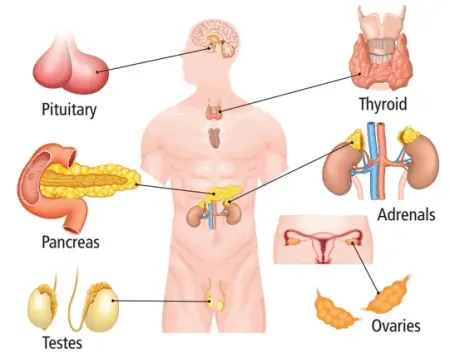The endocrine and exocrine glands are specialized organs which release small amounts of hormones in our body. These hormones affect many changes in the human body both inside and outside. This article explains the differences between these two very important glands.
Summary Table
| Endocrine Glands | Exocrine Glands |
| Release hormones into the bloodstream | Release enzymes through various ducts |
| Include thyroid and parathyroid glands, testes, ovaries, pituitary, pineal, and adrenal glands | Include sweat glands, mammary glands, and salivary glands |
| Responsible for regulating growth, reproductive functions, breast milk production, etc. | Responsible for regulating digestion, body temperature, and keeping the eyes from drying out |
Descriptions

Endocrine glands are glands of the endocrine system responsible for secreting hormones into the blood. These hormones are responsible for the many physiological processes in our body such as metabolism, reproductive functions, menstrual flow, and more. The endocrine system is composed of major glands such as the pituitary gland, pineal gland, pancreas, testes, ovaries, the parathyroid and thyroid glands, adrenal glands, and the hypothalamus.
The endocrine glands secrete hormones into the blood. This makes the body’s response time to these hormones relatively slow as the blood carries them throughout the body. Although the response time is long, the effects of these secretions last for a long time. This is possible because the blood containing the secretion is filtered by the kidneys prior to being delivered to the target organ.

Exocrine glands are glands that are responsible for substances that pass through a network of ducts and are eventually released into an internal or external surface. These surfaces include the mammary glands, sebaceous glands, and mucus-producing glands. Examples of these glands include sweat glands, salivary glands, and digestive glands. These glands secrete substances that aid in regulating a number essential body functions. The lacrimal glands located in the eyes help make sure the eyes do not dry out. Fluids secreted by the sweat glands help regulate body temperature.
Secretions from the exocrine glands respond quicker as these secretions are transferred through some ducts and released exactly at the target area. In addition, exocrine glandular secretions do not pass through the kidney and no reabsorption takes place. Thus, the effects of these secretions do not last very long. For instance, sweating and crying do not last long and they stop after a length of time.
Exocrine glands are characterized by a duct portion (either branched or unbranched ducts) and a glandular portion. The glandular portion may either be tubular glands or acinar (i.e. alveolar glands). It can also be a combination of the two and is called tubuloacinar. A glandular portion that branches is called a branched gland. In terms of how substances are excreted, exocrine glands are grouped into holocrine, apocrine, and merocrine glands.
Endocrine vs Exocrine Glands
So what’s the difference between endocrine and exocrine glands? While there are a handful of organs in the human body that function as both (e.g. liver, pancreas), endocrine glands work differently than exocrine glands.
Endocrine glands secrete hormones into the blood. These hormones released into the bloodstream control various physiological processes such as metabolism, reproductive functions, and menstrual flow, to name a few. On the other hand, exocrine glands produce substances that are secreted onto epithelial (tissue) surfaces through a duct. These enzymes help regulate essential processes of the body such as sweating, food digestion, and keeping the eyes from drying out.
Video
Here’s a video presentation showing the difference between endocrine and exocrine glands.





